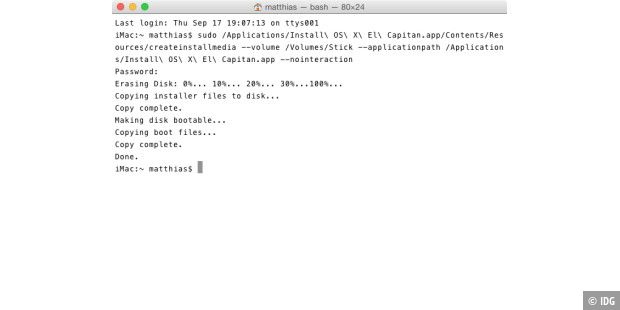
- Create bootable usb for mac os x el capitan how to#
- Create bootable usb for mac os x el capitan install#
- Create bootable usb for mac os x el capitan software#
- Create bootable usb for mac os x el capitan password#
Launch the App Store app, then look for macOS Sierra in the store. Macworld also has bootable-install-drive instructions for:
Create bootable usb for mac os x el capitan how to#
Here’s how to create a bootable macOS Sierra installer drive.
Create bootable usb for mac os x el capitan software#
The installer software will take up nearly 5GB of storage space. You can create a bootable USB flash drive with the macOS Sierra installer that’s now available. When I need to tend to a bunch of Macs, it’s much faster to use a bootable drive instead of going to each Mac, launching the App Store, searching for the operating system, downloading it (after entering my Apple ID), and then running the installer. That’s why I like to make a bootable external drive for the sole purpose of installing the Mac operating system. And if you have multiple Macs, it’s inefficient to download the new OS to each and every Mac. It’s convenient, but sometimes it can take a while for a download to finish. How to create a bootable macOS Sierra installer driveīy Roman Loyola at Senior Editor, Macworld | 1:32 PM PDTĪpple uses its App Store to distribute its software, like new Mac operating systems. Follow the instructions when the macOS installer opens.*Quick note from Save Apple Dollars - Older OS X Images can now be downloaded directly from Apple at please right click on the image link and select “save as”. Select the volume containing the bootable installer, then select ‘Continue’.

Hold the power button until you see the startup options window. Make sure this machine is connected to the internet and supports the macOS version you’re installing.
Create bootable usb for mac os x el capitan install#
Click ‘Continue’ and follow the instructions.įirst, plug the bootable installer into the Mac you wish to install macOS. Select ‘Install macOS’ or ‘Install OS X’ from the Utilities window. Select the volume that contains the bootable installer. Release the ‘Option’ key when you see a dark screen showing your bootable volumes. Press and hold the ‘Option’ key after turning on or restarting the Mac. Plug the bootable installer into a Mac that’s connected to the internet and is compatible with the macOS version you’re installing. The steps are different, depending on whether you're using an Intel-based Mac or one with Apple silicon. It's now time to use the bootable installer to install a fresh copy of macOS. You've now successfully created a bootable installer that you can use to install macOS on other machines. If asked, click 'OK' to allow the copying of files to proceed.

Type 'Y' to confirm that you want to erase the volume, then press 'Return'.
Create bootable usb for mac os x el capitan password#
Type your administrator password when prompted, then press 'Return' again. Continue with TerminalĪfter pasting the command above, hit the 'Return' key. Change the name in the command to match your settings, if necessary.įor macOS Big Sur, copy and paste the following into Terminal: sudo /Applications/Install\ macOS\ Big\ Sur.app/Contents/Resources/createinstallmedia -volume /Volumes/MyVolumeįor macOS Catalina: sudo /Applications/Install\ macOS\ Catalina.app/Contents/Resources/createinstallmedia -volume /Volumes/MyVolumeįor macOS Mojave: sudo /Applications/Install\ macOS\ Mojave.app/Contents/Resources/createinstallmedia -volume /Volumes/MyVolumeįor macOS High Sierra: sudo /Applications/Install\ macOS\ High\ Sierra.app/Contents/Resources/createinstallmedia -volume /Volumes/MyVolumeįor OS X El Capitan: sudo /Applications/Install\ OS\ X\ El\ Capitan.app/Contents/Resources/createinstallmedia -volume /Volumes/MyVolume -applicationpath /Applications/Install\ OS\ X\ El\ Capitan.app 3. With each command, it's assumed the installer is located in your 'Applications' folder and 'MyVolume' is the name of the USB flash drive. The command differs, depending on the macOS version you're going to install. In the next step, you'll enter a command in Terminal. Choose 'Finder' then select 'Go' from the menu bar.

Connect the USB flash drive to the computer you wish to install macOS. Once you have your bootable installer ready, it's time to move to the next step.


 0 kommentar(er)
0 kommentar(er)
